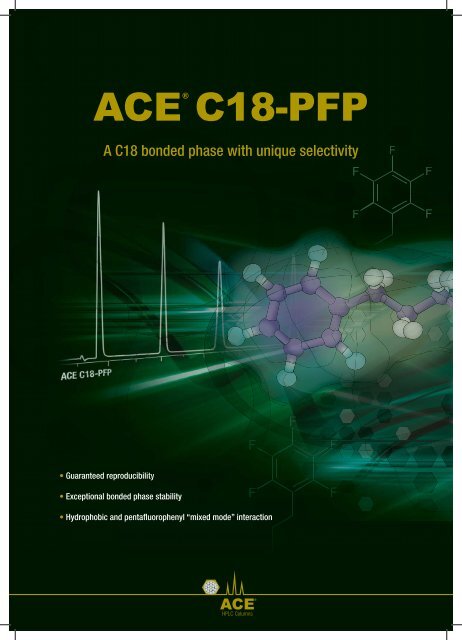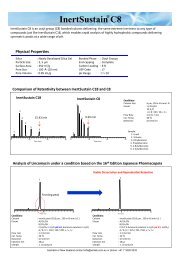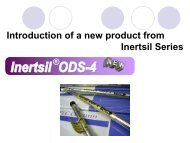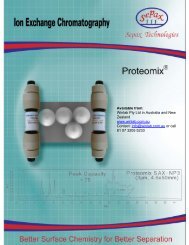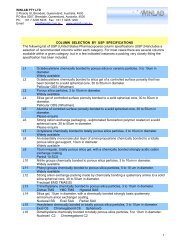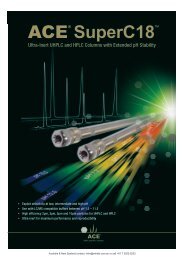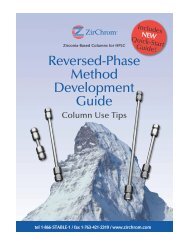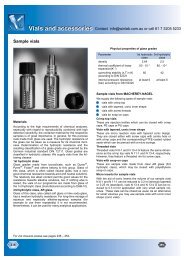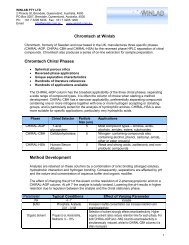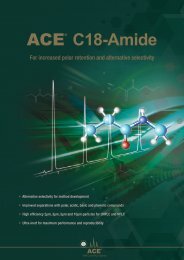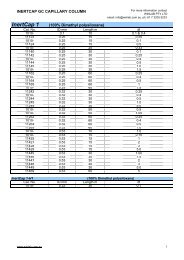ACE PFP Brochure - Winlab.com.au
ACE PFP Brochure - Winlab.com.au
ACE PFP Brochure - Winlab.com.au
You also want an ePaper? Increase the reach of your titles
YUMPU automatically turns print PDFs into web optimized ePapers that Google loves.
<strong>ACE</strong> C18-<strong>PFP</strong><br />
A C18 bonded phase with unique selectivity<br />
<br />
<br />
<br />
<br />
<br />
<br />
<br />
<br />
Guaranteed reproducibility<br />
Exceptional bonded phase stability<br />
<br />
<br />
Hydrophobic and pentafluorophenyl “mixed mode” interaction<br />
HPLC Columns
<strong>ACE</strong> C18-<strong>PFP</strong> – a C18 phase with unique selectivity<br />
Explore the Advantages of <strong>ACE</strong> C18-<strong>PFP</strong><br />
a unique C18 bonded HPLC column with the extra<br />
selectivity of a pentafluorophenyl (<strong>PFP</strong>) phase<br />
• Combines C18 and <strong>PFP</strong> mechanisms of separation to separate mixtures not<br />
possible with either phase alone<br />
• Improved retention of polar basic <strong>com</strong>pounds for better separations<br />
• Ultra inert, ultra high purity silica, for excellent peak shape and<br />
reproducibility<br />
• Exceptional bonded phase stability for elevated temperature applications<br />
• Ultra low bleed phase ensures UV and LC/MS <strong>com</strong>patibility<br />
• Available in high throughput column dimensions<br />
Contents<br />
Page<br />
Alternate Selectivity to “Standard” C18 Columns .............................1<br />
Improving Resolution – Resolution Equation .................................2<br />
Improving Resolution – Selectivity or Efficiency .............................3<br />
<strong>PFP</strong>SeparationMechanisms ................................................4<br />
Applications<br />
#1 Substituted Methoxybenzene Isomers – Leading C18 Columns ......5<br />
#2 Substituted Methoxybenzene Isomers – <strong>PFP</strong> Columns ..............6<br />
#3 Substituted Dinitrobenzene Isomers ..............................7<br />
#4 Pharmaceutically Relevant Analytes ...............................8<br />
#5 Structurally Diverse Analytes .................................... 9<br />
#6 Acidic Analytes .................................................10<br />
#7 Catecholamines ...............................................10<br />
Comparison of Column Inertness ..........................................11<br />
Temperature and pH Stability .............................................12<br />
Reproducibility and Scalability .............................................13<br />
Low Bleed for UV and LC/MS Compatibility ............................14-15<br />
Material Characteristics ...................................................16<br />
Ordering Information<br />
Columns .....................................................16-17<br />
Method Validation Kits .............................................17<br />
<strong>ACE</strong> Ultra Inert Base Deactivated HPLC Columns<br />
www.ace-hplc.<strong>com</strong>
<strong>ACE</strong> C18-<strong>PFP</strong> – a C18 phase with unique selectivity<br />
Why do I need another new C18 phase<br />
The use of an ultra pure, ultra inert silica has many recognised benefits including improved reproducibility, lifetime<br />
and chromatographic performance (particularly with basic molecules). However, since the ultra inert silica surface<br />
effectively no longer contributes to the separation, C18 columns manufactured with high purity silicas show near<br />
identical selectivity. It is therefore highly likely that a problem separation on one leading brand will not be<br />
significantly improved by changing to an alternate manufacturer’s equivalent product.<br />
For many years, experienced chromatographers have been seeking phases with the proven performance and<br />
reproducibility benefits shown by such leading C18 column brands, but which additionally provide the alternate<br />
selectivity required for their challenging applications.<br />
How is <strong>ACE</strong> C18-<strong>PFP</strong> different<br />
C18 bonded phases currently dominate the HPLC<br />
market, with recent surveys indicating that they<br />
are still responsible for 50-60% of all HPLC<br />
columns sold. In recent years the use of<br />
PentaFluoroPhenyl (<strong>PFP</strong>) bonded phases has<br />
grown significantly due to the alternate selectivity<br />
they provide.<br />
However, <strong>com</strong>pared to C18 bonded phases, <strong>PFP</strong><br />
phases have traditionally been <strong>com</strong>promised with<br />
reduced hydrophobicity, reduced stability and<br />
significant column bleed.<br />
<strong>ACE</strong> C18-<strong>PFP</strong> shows alternate selectivity to C18 bonded columns<br />
<strong>ACE</strong> C18<br />
1,2<br />
3<br />
The <strong>ACE</strong> C18-<strong>PFP</strong> phase utilises a specially<br />
developed ligand <strong>com</strong>bining a C18 chain with<br />
integral <strong>PFP</strong> functionality, resulting in a phase that<br />
maintains the hydrophobic, stability and low bleed<br />
characteristics of leading C18 phases, yet provides<br />
the multiple retention mechanisms of a <strong>PFP</strong> phase<br />
that are responsible for the unique selectivity of<br />
<strong>ACE</strong> C18-<strong>PFP</strong> (as further detailed on page 4).<br />
<strong>ACE</strong> C18-<strong>PFP</strong><br />
1<br />
3<br />
2<br />
“<strong>ACE</strong> C18-<strong>PFP</strong> is a valuable method development<br />
tool – a column <strong>com</strong>bining C18 retention and<br />
stability with <strong>PFP</strong> selectivity”<br />
R&D Team Leader, Leading Pharmaceutical Company<br />
0 1 2 3 4 5 6 7<br />
Minutes<br />
Compounds: 1) 1,2,3-trimethoxybenzene 2) 1,2,4-trimethoxybenzene 3) 1,2-dimethoxybenzene<br />
Column: 150 x 4.6 mm, 5μm Flow Rate: 1.00 ml/min Temperature: 40°C Detection: UV, 254 nm<br />
Mobile Phase: 50:50 v/v MeOH/H 2 O<br />
8 9<br />
When should I use <strong>ACE</strong> C18-<strong>PFP</strong><br />
Due to their similar hydrophobic characteristics, <strong>ACE</strong> C18-<strong>PFP</strong> columns may be used for applications in which<br />
“standard” C18 columns would normally be considered. However, due to its integral pentafluorophenyl functionality,<br />
<strong>ACE</strong> C18-<strong>PFP</strong> is additionally re<strong>com</strong>mended for separations that involve halogenated aromatic <strong>com</strong>pounds,<br />
regioisomers and those analytes with differing shape constraints.<br />
As the applications contained within this brochure demonstrate, <strong>ACE</strong> C18-<strong>PFP</strong> can be used to improve separations<br />
that are proving problematic on C18 columns. The unique <strong>ACE</strong> C18-<strong>PFP</strong> phase provides an alternate selectivity to<br />
C18 columns, but remains a valid selection for methods in which C18 bonded columns are specified. In many<br />
instances, the same evaluation conditions that prove unsuitable for the C18 column prove suitable for the C18-<strong>PFP</strong><br />
column, avoiding the need for lengthy method redevelopment.<br />
www.ace-hplc.<strong>com</strong><br />
<strong>ACE</strong> Ultra Inert Base Deactivated HPLC Columns 1
<strong>ACE</strong> C18-<strong>PFP</strong> – a C18 phase with unique selectivity<br />
Improve Chromatographic Resolution<br />
The goal of chromatographic separation is to obtain adequate resolution (R s ) of the <strong>com</strong>ponents of interest in the<br />
minimum time. Baseline separation is achieved with a resolution of 1.5, although for rugged, reproducible methods<br />
that can be readily transferred between laboratories, a resolution of 1.8-2.0 is desirable.<br />
The resolution equation tells us what variables affect resolution:<br />
R s = Resolution between peaks of interest<br />
N = Efficiency – measured by theoretical plates<br />
α = Selectivity – the ratio of retention (k values) for two peaks<br />
k = Retention factor – the number of column volumes required to elute a peak<br />
Efficiency<br />
Selectivity<br />
Retention<br />
Factor<br />
Resolution, R s , can be increased by increasing either N, α or k. However, increasing either N or k to improve R s suffers<br />
from quickly diminishing returns, as can be seen graphically demonstrated in Figure 1 below. For example, R s increases<br />
only with the square root of the increase in N. N can be increased by either adding column length or decreasing the<br />
particle size of the column packing material, or some <strong>com</strong>bination of the two. Either way, the system back pressure<br />
increases with increases in N, so the “cost” of achieving a satisfactory separation by increasing N can be extremely<br />
high pressure.<br />
Similarly, increasing retention (k values) will increase R s , but also with quickly diminishing returns. Increasing k beyond<br />
a value of 10 is usually a poor trade-off between R s and analysis time, as only marginal gains in R s are achieved with<br />
increasing retention times. A graphic representation of this effect can also be seen in Figure 1 below.<br />
Figure 1. The Effect of N, α and k on Resolution (R s )<br />
For a typical separation where: N = 10,000, k =4,α = 1.1<br />
Resolution<br />
(R s )<br />
Increasing N, α or k increases resolution (R s ). However, as can be seen from these plots, increasing either N or k<br />
suffers from quickly diminishing returns. Increasing selectivity (α) on the other hand, does not have this problem<br />
and, therefore, be<strong>com</strong>es the most powerful of these three variables to optimise when developing a separation.<br />
Increasing α increases R s but, unlike N and k, without the constraint of diminishing returns. Changes in α also have<br />
no effect on pressure and only negligible effects on separation time (see Figure 2). Therefore, α is the most powerful<br />
variable to change when developing a separation. Optimising α can allow you to achieve satisfactory resolution<br />
between all peaks of interest, while keeping system back pressure and separation times acceptable.<br />
2 <strong>ACE</strong> Ultra Inert Base Deactivated HPLC Columns<br />
www.ace-hplc.<strong>com</strong>
<strong>ACE</strong> C18-<strong>PFP</strong> – a C18 phase with unique selectivity<br />
Improve Chromatographic Resolution – Selectivity or Efficiency<br />
Selectivity (α) is controlled by the mobile phase, temperature and stationary phase chemistry. Most method<br />
development strategies will explore all of these chromatographic variables.<br />
When sufficient resolution is not achieved with a “standard” 3μm C18 phase, it is re<strong>com</strong>mended to optimise the<br />
chromatographic selectivity of the separation rather than the separation efficiency, as highlighted in the following<br />
example.<br />
By simply changing the stationary phase chemistry (i.e. column) to one with an alternate chromatographic<br />
selectivity, the desired resolution can be readily obtained on a standard HPLC system without the need for expensive<br />
UHPLC instrumentation. Complex mobile phase <strong>com</strong>positions, elevated temperature and aggressive pH conditions<br />
may also be avoided.<br />
Figure 2. Leveraging Selectivity to Achieve Fast, High Resolution Separations<br />
1<br />
12<br />
<strong>ACE</strong> 3 C18<br />
(P max = 240 bar)<br />
2<br />
7<br />
3,4<br />
5<br />
6<br />
10<br />
9<br />
8 11<br />
13<br />
Reducing particle size to<br />
sub-2μm does not<br />
materially improve separation<br />
Leading
<strong>ACE</strong> C18-<strong>PFP</strong> – a C18 phase with unique selectivity<br />
<strong>PFP</strong> Separation Mechanisms<br />
The <strong>ACE</strong> C18-<strong>PFP</strong> phase exhibits multiple retention mechanisms including hydrophobic, π-π interaction, dipole-dipole,<br />
hydrogen bonding and shape selectivity. Whilst approximations of relative strengths are provided below, the<br />
predominance of each retention mechanism is dictated by the solute’s physico/chemical properties, its structure and<br />
the chromatographic conditions employed.<br />
Separation Mechanism Typical C18 Typical <strong>PFP</strong> <strong>ACE</strong> C18-<strong>PFP</strong><br />
Hydrophobicity ++++ +/++ ++++<br />
π-π Interaction - +++ +++<br />
Dipole-Dipole - ++++ ++++<br />
Hydrogen Bonding - +++ +++<br />
Shape Selectivity ++ +++ ++++<br />
π-π Interaction<br />
The <strong>PFP</strong> rings add aromatic character to the surface of the<br />
phase. However, <strong>PFP</strong> phases are different from phenyl<br />
phases since the electronegative fluorine atoms produce an<br />
electron deficient phenyl ring, which makes the <strong>PFP</strong> phase<br />
act as a Lewis acid. This will interact with an analyte able to<br />
donate electrons (i.e. a Lewis base).<br />
This is the opposite of phenyl phases, which contain an<br />
electron rich aromatic ring (due to the absence of electron<br />
withdrawing groups) and which therefore act as Lewis bases.<br />
Analyte<br />
Stationary phase<br />
Dipole-dipole and hydrogen bonding<br />
The carbon-fluorine bonds in the <strong>PFP</strong> ring are extremely<br />
polar. Therefore, <strong>PFP</strong> phases can additionally retain analytes<br />
by dipole-dipole or hydrogen bonding interactions that<br />
occur between the analyte and the electronegative fluorine<br />
atoms. Any such interactions will result in increased<br />
retention.<br />
Analytes<br />
Stationary phase<br />
Analytes<br />
Shape selectivity<br />
The <strong>PFP</strong> has a rigid ring structure which, when <strong>com</strong>bined<br />
with the other retention mechanisms that are possible,<br />
confers outstanding shape selectivity on the <strong>PFP</strong> phase.<br />
Stationary<br />
phase<br />
The <strong>ACE</strong> C18-<strong>PFP</strong> phase exhibits the multiple retention mechanisms of a <strong>PFP</strong> phase, which chromatographers may<br />
exploit in order to resolve mixtures that are difficult, if not impossible, to separate on traditional C18 phases (which<br />
rely primarily on hydrophobic retention mechanisms only).<br />
4 <strong>ACE</strong> Ultra Inert Base Deactivated HPLC Columns<br />
www.ace-hplc.<strong>com</strong>
<strong>ACE</strong> C18-<strong>PFP</strong> – a C18 phase with unique selectivity<br />
Application #1 - Substituted Methoxybenzene Isomers - Leading C18 Columns<br />
1,2<br />
3<br />
Hydrophobic reference<br />
<strong>ACE</strong> 3 C18<br />
5,6<br />
7<br />
8<br />
4<br />
1,2,3<br />
Waters Sunfire<br />
3.5 C18<br />
4<br />
5 6<br />
7<br />
8<br />
1,2,3<br />
Zorbax Eclipse<br />
XDB 3.5 C18<br />
4<br />
5,6<br />
7<br />
8<br />
1,2,3<br />
Luna 3 C18(2)<br />
4<br />
5 6<br />
7<br />
8<br />
1<br />
Enhanced resolution<br />
3<br />
<strong>ACE</strong> 3 C18-<strong>PFP</strong><br />
2<br />
5<br />
6<br />
7<br />
8<br />
4<br />
0 5<br />
10 15 20 25<br />
Minutes<br />
Sample: 1) 1,2,3-trimethoxybenzene 2) 1,2,4-trimethoxybenzene 3) 1,2-dimethoxybenzene 4) 1,4-dimethoxybenzene 5) methoxybenzene 6) 1,3-dimethoxybenzene<br />
7) 1,3,5-trimethoxybenzene 8) neutral molecule (reference).<br />
Column Dimensions: 150 x 4.6 mm Flow Rate: 1.00 ml/min Temperature: 40°C Detection: UV, 254 nm Mobile Phase: 50:50 v/v MeOH/H 2 O<br />
The above example highlights the fact that leading C18 brands provide similar selectivity and all fail to separate tri-,<br />
di- and monomethoxybenzene isomers. The differences in absolute retention (as illustrated by the neutral reference<br />
marker) are due to purely hydrophobic effects and related to parent silica characteristics (e.g. surface area).<br />
The <strong>ACE</strong> C18-<strong>PFP</strong> exhibits excellent resolution of all <strong>com</strong>ponents, resulting from the integral <strong>PFP</strong> functionality<br />
contained within the unique <strong>ACE</strong> C18-<strong>PFP</strong> ligand.<br />
www.ace-hplc.<strong>com</strong><br />
<strong>ACE</strong> Ultra Inert Base Deactivated HPLC Columns 5
<strong>ACE</strong> C18-<strong>PFP</strong> – a C18 phase with unique selectivity<br />
Application #2 - Substituted Methoxybenzene Isomers - <strong>PFP</strong> Columns<br />
1,2<br />
Hydrophobic reference<br />
3<br />
5,6<br />
<strong>ACE</strong>3C18<br />
7<br />
8<br />
4<br />
1 2<br />
3<br />
8<br />
Loss of Hydrophobicity<br />
Alternate selectivity –<br />
but significant decrease<br />
in hydrophobicity<br />
Typical 3μm <strong>PFP</strong><br />
5<br />
6<br />
7<br />
4<br />
<strong>ACE</strong> 3 C18-<strong>PFP</strong><br />
1<br />
3<br />
2<br />
5<br />
6<br />
7<br />
8<br />
Alternate selectivity –<br />
but hydrophobicity<br />
maintained<br />
4<br />
0 5<br />
10 15 20 25<br />
Minutes<br />
Sample: 1) 1,2,3-trimethoxybenzene 2) 1,2,4-trimethoxybenzene 3) 1,2-dimethoxybenzene 4) 1,4-dimethoxybenzene 5) methoxybenzene 6) 1,3-dimethoxybenzene<br />
7) 1,3,5-trimethoxybenzene 8) neutral molecule (reference)<br />
Column Dimensions: 150 x 4.6 mm Flow Rate: 1.00 ml/min Temperature: 40°C Detection: UV, 254 nm<br />
Mobile Phase: 50:50 v/v MeOH/H 2 O<br />
The above application highlights the usefulness of pentafluorophenyl phases in the separation of regioisomers. As<br />
previously shown on page 5, standard C18 phases fail to separate the tri-, di- and monomethoxybenzene isomers.<br />
Traditional <strong>PFP</strong> phases provide an alternate selectivity but at the expense of a significant decrease in hydrophobicity,<br />
which <strong>com</strong>promises the separation.<br />
The <strong>ACE</strong> C18-<strong>PFP</strong> maintains the hydrophobic characteristics of a C18 phase and provides a superior separation that<br />
can be further optimised to reduce analysis time.<br />
6 <strong>ACE</strong> Ultra Inert Base Deactivated HPLC Columns<br />
www.ace-hplc.<strong>com</strong>
<strong>ACE</strong> C18-<strong>PFP</strong> – a C18 phase with unique selectivity<br />
Application #3 - Substituted Dinitrobenzene Isomers<br />
2<br />
1<br />
3<br />
Hydrophobic reference<br />
<strong>ACE</strong>5C18<br />
4<br />
1,2<br />
3<br />
Luna 5 C18(2)<br />
4<br />
<strong>ACE</strong> 5 C18-<strong>PFP</strong><br />
2<br />
3<br />
1<br />
Enhanced resolution<br />
4<br />
C18-<strong>PFP</strong> achieves<br />
baseline separation<br />
of all isomers<br />
0 5<br />
10 15 20 25 30<br />
Minutes<br />
35 40 45<br />
Sample: 1) 1,2-dinitrobenzene 2) 1,4-dinitrobenzene 3) 1,3-dinitrobenzene 4) neutral molecule (reference).<br />
Column Dimensions: 150 x 4.6 mm Flow Rate: 1.00 ml/min Temperature: 40°C Detection: UV, 214 nm<br />
Mobile Phase: 50:50 v/v MeOH/H 2 O<br />
This test containing aromatic dinitrobenzene isomers, performed under simple isocratic conditions, highlights that<br />
while the three phases possess similar hydrophobicities, the C18-<strong>PFP</strong> phase exhibits differing chromatographic<br />
selectivity (via an enhanced dipole-dipole interaction) towards the dinitrobenzene isomers <strong>com</strong>pared to the C18<br />
phases.<br />
Both C18 phases fail to separate the isomers under these conditions while the C18-<strong>PFP</strong> achieves baseline separation<br />
of all the isomers due to its integral <strong>PFP</strong> functionality providing additional retention mechanisms.<br />
www.ace-hplc.<strong>com</strong><br />
<strong>ACE</strong> Ultra Inert Base Deactivated HPLC Columns 7
<strong>ACE</strong> C18-<strong>PFP</strong> – a C18 phase with unique selectivity<br />
Application #4 - Pharmaceutically Relevant Analytes<br />
9<br />
11,13,14<br />
1<br />
3,5<br />
17<br />
<strong>ACE</strong> 3 C18<br />
7<br />
12<br />
2<br />
4<br />
6<br />
8<br />
10<br />
15 16<br />
7,11<br />
A typical <strong>PFP</strong> column<br />
9<br />
Typical 3μm <strong>PFP</strong><br />
1<br />
12<br />
17<br />
changes selectivity -<br />
but critical pairs still<br />
result<br />
3<br />
2<br />
5<br />
4,6<br />
10<br />
13<br />
8<br />
15<br />
16<br />
14<br />
9<br />
1<br />
11<br />
C18-<strong>PFP</strong> achieves<br />
<strong>ACE</strong> 3 C18-<strong>PFP</strong><br />
2<br />
3<br />
4<br />
5<br />
6<br />
7<br />
8<br />
12<br />
14<br />
10 13 15 16<br />
17<br />
resolution of all<br />
17 <strong>com</strong>ponents<br />
Sample: 1) sulphanilamide 2) nizatidine 3) metronidazole 4) amiloride 5) hydrochlorothiazide 6) caffeine 7) pindolol 8) metoprolol 9) phenacetin 10) 1,3-dinitrobenzene<br />
11) hexobarbitol 12) furosemide 13) piroxicam 14) carvedilol 15) ketoprofen 16) ibuprofen 17) indomethacin<br />
Column Dimensions: 50 x 2.1 mm Flow Rate: 0.60 ml/min Temperature: 40°C Detection: UV, 254 nm<br />
Mobile Phase: A = 0.1% v/v formic acid in H 2 O and B = 0.1% v/v formic acid in MeOH<br />
Gradient = 3 to 100% B in 5 minutes<br />
0 1<br />
2 3 4 5 6<br />
Minutes<br />
The above application shows the separation of a range of pharmaceutically active analytes on an <strong>ACE</strong> C18 column,<br />
with 2 sets of co-eluting peaks being observed. This separation on the <strong>ACE</strong> C18 is also consistent with that expected<br />
with other leading C18 column brands, which exhibit very similar selectivity due to the same (predominantly<br />
hydrophobic) retention mechanism.<br />
Changing to a typical <strong>PFP</strong> phase results in a change of selectivity, but different critical pairs now result.<br />
The same evaluation conditions that proved unsuitable for the <strong>ACE</strong> C18 and a typical <strong>PFP</strong> phase, were found to be<br />
suitable for the <strong>ACE</strong> C18-<strong>PFP</strong> column, enabling resolution of all 17 <strong>com</strong>ponents including all critical pairs previously<br />
identified.<br />
8 <strong>ACE</strong> Ultra Inert Base Deactivated HPLC Columns<br />
www.ace-hplc.<strong>com</strong>
<strong>ACE</strong> C18-<strong>PFP</strong> – a C18 phase with unique selectivity<br />
Application #5 - Structurally Diverse Analytes<br />
1<br />
12<br />
2<br />
<strong>ACE</strong> 3 C18<br />
7<br />
6<br />
3,4<br />
5<br />
10<br />
13<br />
9<br />
8<br />
11<br />
1<br />
12<br />
<strong>ACE</strong> C18-<strong>PFP</strong><br />
pulls peaks apart!<br />
2<br />
<strong>ACE</strong> 3 C18-<strong>PFP</strong><br />
7<br />
3<br />
4<br />
5<br />
6<br />
8<br />
9<br />
10<br />
11<br />
13<br />
0 1<br />
2 3 4 5<br />
Minutes<br />
Sample: 1) paracetamol 2) hydrochlorothiazide 3) methylphenylsulphoxide 4) methylphenylsulphone 5) aspirin 6) phenacetin 7) 1,3-dinitrobenzene<br />
8) 1,2,4-trimethoxybenzene 9) ethylbenzoate 10) nimesulide 11) ibuprofen 12) indomethacin 13) mefenamic acid<br />
Column Dimensions: 50 x 2.1 mm Flow Rate: 0.60 ml/min Temperature: 40°C Detection: UV, 254 nm<br />
Mobile Phase: A=5mMformic acid in H 2 O andB=5mMformic acid in MeOH<br />
Gradient =3to100% B in 5 minutes<br />
Based upon the same ultra inert, ultra high purity silica platform as <strong>ACE</strong> C18, the unique <strong>ACE</strong> C18-<strong>PFP</strong> phase again<br />
provides alternate selectivity, leading to superior resolution of all 13 structurally diverse analytes, without the need<br />
for lengthy method redevelopment.<br />
www.ace-hplc.<strong>com</strong><br />
<strong>ACE</strong> Ultra Inert Base Deactivated HPLC Columns 9
<strong>ACE</strong> C18-<strong>PFP</strong> – a C18 phase with unique selectivity<br />
Application #6 - Acidic Analytes<br />
3<br />
2<br />
4<br />
<strong>ACE</strong> 3 C18<br />
1<br />
1<br />
3<br />
2<br />
4<br />
5<br />
6,7<br />
8<br />
5<br />
7<br />
6<br />
10<br />
9 11 12<br />
<strong>ACE</strong> 3 C18-<strong>PFP</strong><br />
Additional retention<br />
mechanisms result in<br />
dramatically different<br />
selectivity<br />
10<br />
8<br />
9 12<br />
11<br />
Sample:<br />
1) benzene sulphonic acid<br />
2) 4-hydroxybenzoic acid<br />
3) 3-hydroxybenzoic acid<br />
4) phenol<br />
5) 2-hydroxybenzoic acid<br />
6) sorbic acid<br />
7) benzoic acid<br />
8) dimethylphthalate<br />
9) 3-phenylpropionic acid<br />
10) cinnamic acid<br />
11) 4-hydroxybenzoic acid propyl ester<br />
12) neutral molecule (reference)<br />
Column Dimensions: 150 x 4.6 mm, 3μm<br />
Flow Rate: 1.00 ml/min<br />
Temperature: 40°C<br />
Detection: UV, 214 nm<br />
Mobile Phase = 65:35 v/v 5 mM KH 2 PO 4<br />
(pH 2.5) in H 2 O/MeOH<br />
0 10<br />
20 30 40 50 60<br />
Minutes<br />
70<br />
The additional retention mechanism provided by the <strong>ACE</strong> C18-<strong>PFP</strong> phase results in dramatically different<br />
chromatographic selectivity <strong>com</strong>pared to a typical C18 phase, including many reversals in peak elution order.<br />
Application #7 - Catecholamines<br />
1<br />
3<br />
2<br />
Typical 5μm <strong>PFP</strong><br />
4<br />
5<br />
<strong>ACE</strong> 5 C18-<strong>PFP</strong><br />
1<br />
3<br />
2<br />
Added hydrophobic interaction<br />
leads to better separation<br />
4<br />
5<br />
Sample:<br />
1) norepinephrine<br />
2) levodopa<br />
3) epinephrine<br />
4) tyrosine<br />
5) dopamine<br />
Column Dimensions: 150 x 4.6 mm, 5μm<br />
Flow Rate: 1.00 ml/min<br />
Temperature: 22°C<br />
Detection: UV, 266 nm<br />
Mobile Phase = 12.5 mM ammonium<br />
formate (pH 3.0) in H 2 O<br />
0 2.5<br />
5 7.5 10<br />
Minutes<br />
This separation of catecholamines illustrates how strong hydrophobic binding interaction on the <strong>ACE</strong> C18-<strong>PFP</strong><br />
provides a better separation of levodopa and epinephrine than is achieved by a typical <strong>PFP</strong> with weak hydrophobic<br />
binding interaction.<br />
10 <strong>ACE</strong> Ultra Inert Base Deactivated HPLC Columns<br />
www.ace-hplc.<strong>com</strong>
HPLC COLUM<br />
S<br />
Com a son a a on omm n y U ed C 8 P as s<br />
■ a o a y h se p i c i ns<br />
■ hss o prdA od goRl ie yr hbcy<br />
■ o pr on f o mn fc nyoaNuaCmond<br />
■ hss o prdA od goMtl cvy<br />
■ hss rue Ac dn t Slnl t iy<br />
■ o p r on f o mn f c n y o B s c o p u ds<br />
■ a gr aon f h es co igo i nl cvyadn tes<br />
<strong>ACE</strong> C18-<strong>PFP</strong> – a C18 phase with unique selectivity<br />
Comparison of Column Inertness<br />
■ Leading 3μm, small pore C18 column brands<br />
■ 50 x 2.1 mm i.d. LC/MS <strong>com</strong>patible dimensions<br />
■ Basic molecule inertness test<br />
■ Peak efficiency and asymmetry investigation<br />
Peak Efficiency Comparison<br />
<strong>ACE</strong> 3 C18-<strong>PFP</strong><br />
<strong>ACE</strong> 3 C18-AR<br />
<strong>ACE</strong> 3 C18<br />
Sunfire 3.5 C18<br />
HyPurity 3 C18<br />
Zorbax XDB 3.5 C18<br />
Zorbax SB 3.5 C18<br />
Luna 3 C18(2)<br />
XBridge 3.5 C18<br />
Inertsil 3 ODS-3<br />
XTerra MS 3.5 C18<br />
Ascentis Express 2.7 C18<br />
Hypersil BDS 3 C18<br />
Spherisorb 3 ODS2<br />
Symmetry 3.5 C18<br />
Hypersil 3 ODS<br />
700<br />
5,600<br />
13,700<br />
12,900<br />
0 6,000 12,000 18,000 24,000 30,000<br />
N 0.1 (pyridine) (plates/m)<br />
30,300<br />
27,100<br />
26,200<br />
24,400<br />
23,200<br />
21,600<br />
21,500<br />
20,300<br />
20,200<br />
19,700<br />
18,400<br />
17,300<br />
Lower Tailing<br />
Higher Tailing<br />
<strong>ACE</strong> 3 C18-<strong>PFP</strong><br />
N 0.1 (pyr) = 30,300pl/m<br />
2<br />
Waters XTerra MS 3.5 C18<br />
N 0.1 (pyr) = 18,400pl/m<br />
2<br />
Waters Symmetry 3.5 C18<br />
N 0.1 (pyr) = 5,600pl/m<br />
2<br />
3<br />
1<br />
3<br />
1<br />
3<br />
1<br />
Column Dimensions: 50 x 2.1 mm Sample: 1) uracil 2) pyridine 3) phenol Mobile Phase: 40:60 v/v MeOH/H 2 O Flow Rate: 0.20 ml/min Temperature: 22°C Wavelength: 254 nm<br />
Conclusion<br />
Significant differences in efficiency, peak shape and selectivity are seen when analysing<br />
pyridine – a small highly basic molecule.<br />
Increased tailing and retention are indicative of undesirable secondary interactions<br />
between pyridine and silanol groups on the stationary phase surface. These<br />
interactions can also result in poor column reproducibility.<br />
<strong>ACE</strong> C18 columns have been previously independently tested and found to be the<br />
highest efficiency, most inert columns available. The new <strong>ACE</strong> C18-<strong>PFP</strong> maintains this<br />
excellent performance.<br />
Si-OH<br />
<strong>ACE</strong> ® Stationary<br />
Phases Virtually<br />
Eliminate the<br />
Negative Effects<br />
of Silanols on HPLC<br />
Separations<br />
ComparisonC<br />
p<br />
Guide<br />
TO C18<br />
ud<br />
REVE SED P HA E<br />
Further inertness test data is contained within the current <strong>ACE</strong> HPLC column catalogue.<br />
Additionally, a Comparison Guide to C18 Columns is also available, detailing material<br />
characteristics for over 50 HPLC column brands and <strong>com</strong>paring performance with a<br />
number of test probes. Please contact your local distributor to request your copies.<br />
www.ace-hplc.<strong>com</strong><br />
<strong>ACE</strong> Ultra Inert Base Deactivated HPLC Columns<br />
11
<strong>ACE</strong> C18-<strong>PFP</strong> – a C18 phase with unique selectivity<br />
Excellent Temperature and pH Stability<br />
At low pH, column deterioration is c<strong>au</strong>sed by hydrolysis of the bonded phase, with a decrease in retention observed.<br />
The nature of the bonded phase, the purity of the silica surface and bonding density are all critical parameters. The<br />
use of a lower purity silica, a shorter ligand and a lower bonding density are all factors that will contribute to<br />
accelerated ligand cleavage and reduced column lifetime.<br />
Accelerated Column Stability Study - 80°C at pH 1.9<br />
100<br />
<strong>ACE</strong> 5 C18-<strong>PFP</strong><br />
(high purity silica)<br />
<strong>ACE</strong> 5 C18<br />
(high purity silica)<br />
80<br />
Leading <strong>PFP</strong><br />
(high purity silica)<br />
% Initial k<br />
60<br />
Zorbax SB-C18<br />
(moderate purity silica)<br />
40<br />
24,000 column volumes<br />
Waters<br />
Spherisorb ODS2<br />
(low purity silica)<br />
30<br />
0 50<br />
100 150 200 250<br />
Time (hours)<br />
Acidic Exposure Conditions: Mobile Phase: 5:95 v/v MeOH/0.1% TFA in H 2 O (pH 1.9)<br />
Flow Rate: 0.20 ml/min<br />
Temperature: 80°C<br />
Column Dimensions: 50 x 2.1 mm<br />
Using conditions designed to accelerate column degradation, the <strong>ACE</strong> C18-<strong>PFP</strong> phase shows little<br />
retention loss, with lifetime equivalent to the highly robust <strong>ACE</strong> C18 phase, suggesting that the <strong>ACE</strong><br />
C18-<strong>PFP</strong> may be suitable for applications in which <strong>PFP</strong> columns exhibit reduced lifetime.<br />
As expected, a C18 bonded column based upon a moderate purity silica (Zorbax SB-C18 – a phase<br />
previously recognised to provide excellent stability for high temperature and low pH applications) and<br />
a low purity silica (Waters Spherisorb ODS2) show significantly reduced lifetimes.<br />
12<br />
<strong>ACE</strong> Ultra Inert Base Deactivated HPLC Columns<br />
www.ace-hplc.<strong>com</strong>
<strong>ACE</strong> C18-<strong>PFP</strong> – a C18 phase with unique selectivity<br />
Guaranteed Reproducibility and Fully Scalable<br />
Of equal importance to alternate selectivity is excellent reproducibility. Variations between different batches of<br />
stationary phase are the most <strong>com</strong>mon c<strong>au</strong>se of customer concern. <strong>ACE</strong> stationary phases virtually eliminate the<br />
unpredictable negative effects of silanols on HPLC separations by maintaining a rigid control of the <strong>com</strong>plete<br />
manufacturing process and establishing tight specifications for purity, selectivity, retention, efficiency and<br />
asymmetry. Therefore, as demonstrated in the figure below, absolute batch-to-batch and column-to-column<br />
reproducibility are guaranteed for all <strong>ACE</strong> C18-<strong>PFP</strong> columns.<br />
Silica Batch #1<br />
1<br />
2<br />
Parent Silica Batch<br />
4<br />
6<br />
3<br />
5<br />
1<br />
2<br />
Silane Batch<br />
4<br />
3<br />
5<br />
6<br />
Silane Batch #1<br />
Silica Batch #2<br />
Silane Batch #2<br />
Silica Batch #3<br />
Silane Batch #3<br />
Minutes<br />
Minutes<br />
<strong>ACE</strong> 3 C18-<strong>PFP</strong><br />
Particle Size<br />
2<br />
4<br />
1 6<br />
3<br />
5<br />
1<br />
2<br />
Column Diameter<br />
4<br />
6<br />
3<br />
5<br />
LC/MS<br />
150 x 2.1 mm<br />
0.21 ml/min<br />
<strong>ACE</strong> 5 C18-<strong>PFP</strong><br />
Analytical<br />
150 x 4.6 mm<br />
1.00 ml/min<br />
<strong>ACE</strong> 10 C18-<strong>PFP</strong><br />
Preparative<br />
150 x 21.2 mm<br />
21.2 ml/min<br />
Minutes<br />
Minutes<br />
Column: <strong>ACE</strong> 5 C18-<strong>PFP</strong>, 150 x 4.6 mm (unless specified otherwise)<br />
Sample: 1) uracil 2) 4-hydroxybenzoic acid 3) acetylsalicylic acid 4) benzoic acid 5) 2-hydroxybenzoic acid 6) ethyl paraben<br />
Mobile Phase: 35:65 v/v MeCN/0.1% TFA in H 2 O Temperature: 22°C Wavelength: 254 nm Flow Rate: 1.00 ml/min (unless specified otherwise)<br />
The availability of 3μm, 5μm and 10μm particle sizes <strong>com</strong>bined with a range of column dimensions from<br />
capillary through to preparative scale ensures that methods can be reproducibly scaled up or down. The<br />
chromatograms above demonstrate the excellent reproducibility achieved when silica batch and silane batch<br />
are changed, and the reproducible scalability obtained when changing particle size and column diameter.<br />
www.ace-hplc.<strong>com</strong><br />
<strong>ACE</strong> Ultra Inert Base Deactivated HPLC Columns 13
<strong>ACE</strong> C18-<strong>PFP</strong> – a C18 phase with unique selectivity<br />
Low Bleed for UV and LC/MS Compatibility<br />
Many phases exhibit bleed of the bonded phase, which is most clearly seen under gradient conditions when baseline<br />
stability is affected. Whilst most ultra pure C18 phases can be expected to give low column bleed, careful selection<br />
of an alternate selectivity bonded phase is required to ensure that column bleed does not c<strong>au</strong>se unforeseen problems<br />
when analysing at low UV wavelengths or by LC/MS. Note, absolute column bleed depends on a number of factors<br />
and may vary from day to day and system to system. Therefore it is important, when <strong>com</strong>paring column bleed, to do<br />
so under controlled conditions.<br />
<strong>ACE</strong> C18-<strong>PFP</strong> Exhibits Low Column Bleed for UV<br />
350<br />
<strong>ACE</strong> 3 C18<br />
9<br />
300<br />
mAU<br />
250<br />
200<br />
150<br />
100<br />
50<br />
0<br />
1<br />
3<br />
2<br />
4<br />
5 6<br />
7<br />
8<br />
<strong>ACE</strong> C18-<strong>PFP</strong> – a C18 phase with unique selectivity<br />
Low Bleed for UV and LC/MS Compatibility (cont’d)<br />
When detecting by MS, the use of non-C18 phases has traditionally presented additional challenges to the analyst.<br />
In extreme instances, column bleed may swamp the detector signal and mask the analyte of interest.<br />
In the following example, column bleed is monitored in the 8-10 minute segment of the gradient run, at which point<br />
the % organic increases to its maximum level and column bleed is therefore also highest. The MS Spectra (left<br />
series) provides an m/z breakdown of the bleed detected during this 8-10 minute window, whereas the Total Ion<br />
Chromatogram (right series) illustrates the bleed obtained during this same 8-10 minute time period.<br />
<strong>ACE</strong> C18-<strong>PFP</strong> Exhibits Low Column Bleed for LC/MS<br />
MS Spectra<br />
Total Ion Chromatogram (TIC)<br />
Leading Polar<br />
Embedded column<br />
222400 cps<br />
Leading C18 column<br />
<strong>ACE</strong> C18-<strong>PFP</strong><br />
Relative Abundance<br />
17200 cps<br />
21100 cps<br />
Abundance<br />
No column (blank)<br />
5600 cps<br />
0 1000 0<br />
time (mins)<br />
10<br />
m/z<br />
Column Dimensions: 50 x 3.0 mm<br />
Flow Rate: 0.43 ml/min<br />
Temperature: 60°C<br />
Detection: +ve ESI fast scan mode (Agilent 1100 MSD), full scan range 50 – 1000m/z<br />
Mobile Phase: A = 0.1% v/v formic acid in H 2 O<br />
B = 0.1% v/v formic acid in MeCN<br />
Gradient: T(mins) %B<br />
0 5<br />
0.1 5<br />
5 95<br />
10 95<br />
10.5 5<br />
The TIC trace and MS spectra for the polar embedded column (previously seen to show significant bleed by<br />
UV detection) again shows a high level of column bleed when analysing by LC/MS. The MS spectra from a<br />
blank run (performed with no column attached) enables the background system bleed to be quantified. Both<br />
the <strong>ACE</strong> C18-<strong>PFP</strong> column and leading C18 column exhibit bleed levels similar to the blank run, denoting that<br />
negligible column bleed is occurring.<br />
Conclusion<br />
The <strong>ACE</strong> C18-<strong>PFP</strong> phase may be used to provide a different selectivity to leading C18 columns without encountering<br />
the column bleed issues associated with many alternate (i.e. non-C18) bonded phases.<br />
www.ace-hplc.<strong>com</strong><br />
<strong>ACE</strong> Ultra Inert Base Deactivated HPLC Columns 15
<strong>ACE</strong> C18-<strong>PFP</strong> – a C18 phase with unique selectivity<br />
Material Characteristics<br />
PHASE FUNCTIONAL GROUP<br />
ENDCAPPED PARTICLE SIZE PORE SIZE (Å) SURF<strong>ACE</strong> AREA CARBON<br />
(μm)<br />
(m 2 /g) LOAD (%)<br />
C18-<strong>PFP</strong> Proprietary octadecyl with<br />
Yes 3, 5, 10 100 300 14.3<br />
embedded <strong>PFP</strong> functionality<br />
C18 Octadecyl Yes 3, 5, 10 100 300 15.5<br />
MAXIMUM<br />
pH RANGE<br />
1.5-10.0 a<br />
1.5-10.0 a<br />
a For optimum column lifetime, a pH range of 2-8 is re<strong>com</strong>mended. To increase column lifetime at high pH, organic buffers, low buffer concentrations, high % organic solvent and low<br />
temperatures must be considered. Further information is contained within “A Guide to HPLC and LC-MS Buffer Selection” by John Dolan – contact your distributor to request your<br />
FREE copy.<br />
<strong>ACE</strong> 3μm Columns (Contact your distributor for the full range of <strong>ACE</strong> 3μm phases available)<br />
<strong>ACE</strong> 3μm C18-<strong>PFP</strong><br />
COLUMN<br />
DIAMETER<br />
COLUMN LENGTH<br />
20 mm 30 mm 35 mm 50 mm 75 mm 100 mm 125 mm 150 mm 250 mm<br />
GUARD<br />
CARTRIDGE<br />
1.0mm - <strong>ACE</strong>-1110-0301 <strong>ACE</strong>-1110-3501 <strong>ACE</strong>-1110-0501 <strong>ACE</strong>-1110-7501 <strong>ACE</strong>-1110-1001 <strong>ACE</strong>-1110-1201 <strong>ACE</strong>-1110-1501 <strong>ACE</strong>-1110-2501 a <strong>ACE</strong>-1110-0101GD 1<br />
2.1mm <strong>ACE</strong>-1110-0202 6 <strong>ACE</strong>-1110-0302 <strong>ACE</strong>-1110-3502 <strong>ACE</strong>-1110-0502 <strong>ACE</strong>-1110-7502 <strong>ACE</strong>-1110-1002 <strong>ACE</strong>-1110-1202 <strong>ACE</strong>-1110-1502 <strong>ACE</strong>-1110-2502 a <strong>ACE</strong>-1110-0102GD 2<br />
3.0mm <strong>ACE</strong>-1110-0203 6 <strong>ACE</strong>-1110-0303 <strong>ACE</strong>-1110-3503 <strong>ACE</strong>-1110-0503 <strong>ACE</strong>-1110-7503 <strong>ACE</strong>-1110-1003 <strong>ACE</strong>-1110-1203 <strong>ACE</strong>-1110-1503 <strong>ACE</strong>-1110-2503 a <strong>ACE</strong>-1110-0103GD 3<br />
4.0mm - - <strong>ACE</strong>-1110-3504 <strong>ACE</strong>-1110-0504 <strong>ACE</strong>-1110-7504 <strong>ACE</strong>-1110-1004 <strong>ACE</strong>-1110-1204 <strong>ACE</strong>-1110-1504 <strong>ACE</strong>-1110-2504 a <strong>ACE</strong>-1110-0103GD 3<br />
4.6mm <strong>ACE</strong>-1110-0246 6 <strong>ACE</strong>-1110-0346 <strong>ACE</strong>-1110-3546 <strong>ACE</strong>-1110-0546 <strong>ACE</strong>-1110-7546 <strong>ACE</strong>-1110-1046 <strong>ACE</strong>-1110-1246 <strong>ACE</strong>-1110-1546 <strong>ACE</strong>-1110-2546 a <strong>ACE</strong>-1110-0103GD 3<br />
<strong>ACE</strong> 3μm C18<br />
COLUMN<br />
DIAMETER<br />
COLUMN LENGTH<br />
20 mm 30 mm 35 mm 50 mm 75 mm 100 mm 125 mm 150 mm 250 mm<br />
GUARD<br />
CARTRIDGE<br />
1.0mm - <strong>ACE</strong>-111-0301 <strong>ACE</strong>-111-3501 <strong>ACE</strong>-111-0501 <strong>ACE</strong>-111-7501 <strong>ACE</strong>-111-1001 <strong>ACE</strong>-111-1201 <strong>ACE</strong>-111-1501 <strong>ACE</strong>-111-2501 a <strong>ACE</strong>-111-0101GD 1<br />
2.1mm <strong>ACE</strong>-111-0202 6 <strong>ACE</strong>-111-0302 <strong>ACE</strong>-111-3502 <strong>ACE</strong>-111-0502 <strong>ACE</strong>-111-7502 <strong>ACE</strong>-111-1002 <strong>ACE</strong>-111-1202 <strong>ACE</strong>-111-1502 <strong>ACE</strong>-111-2502 a <strong>ACE</strong>-111-0102GD 2<br />
3.0mm <strong>ACE</strong>-111-0203 6 <strong>ACE</strong>-111-0303 <strong>ACE</strong>-111-3503 <strong>ACE</strong>-111-0503 <strong>ACE</strong>-111-7503 <strong>ACE</strong>-111-1003 <strong>ACE</strong>-111-1203 <strong>ACE</strong>-111-1503 <strong>ACE</strong>-111-2503 a <strong>ACE</strong>-111-0103GD 3<br />
4.0mm - - <strong>ACE</strong>-111-3504 <strong>ACE</strong>-111-0504 <strong>ACE</strong>-111-7504 <strong>ACE</strong>-111-1004 <strong>ACE</strong>-111-1204 <strong>ACE</strong>-111-1504 <strong>ACE</strong>-111-2504 a <strong>ACE</strong>-111-0103GD 3<br />
4.6mm <strong>ACE</strong>-111-0246 6 <strong>ACE</strong>-111-0346 <strong>ACE</strong>-111-3546 <strong>ACE</strong>-111-0546 <strong>ACE</strong>-111-7546 <strong>ACE</strong>-111-1046 <strong>ACE</strong>-111-1246 <strong>ACE</strong>-111-1546 <strong>ACE</strong>-111-2546 a <strong>ACE</strong>-111-0103GD 3<br />
a Consider operating pressure limitations for maximum column lifetime<br />
<strong>ACE</strong> 5μm Columns (Contact your distributor for the full range of <strong>ACE</strong> 5μm phases available)<br />
<strong>ACE</strong> 5μm C18-<strong>PFP</strong><br />
COLUMN<br />
DIAMETER<br />
COLUMN LENGTH<br />
20 mm 30 mm 35 mm 50 mm 75 mm 100 mm 125 mm<br />
150 mm 250 mm<br />
GUARD<br />
CARTRIDGE<br />
1.0mm - <strong>ACE</strong>-1210-0301 <strong>ACE</strong>-1210-3501 <strong>ACE</strong>-1210-0501 <strong>ACE</strong>-1210-7501 <strong>ACE</strong>-1210-1001 <strong>ACE</strong>-1210-1201 <strong>ACE</strong>-1210-1501 <strong>ACE</strong>-1210-2501 <strong>ACE</strong>-1210-0101GD 1<br />
2.1mm <strong>ACE</strong>-1210-0202 6 <strong>ACE</strong>-1210-0302 <strong>ACE</strong>-1210-3502 <strong>ACE</strong>-1210-0502 <strong>ACE</strong>-1210-7502 <strong>ACE</strong>-1210-1002 <strong>ACE</strong>-1210-1202 <strong>ACE</strong>-1210-1502 <strong>ACE</strong>-1210-2502 <strong>ACE</strong>-1210-0102GD 2<br />
3.0mm <strong>ACE</strong>-1210-0203 6 <strong>ACE</strong>-1210-0303 <strong>ACE</strong>-1210-3503 <strong>ACE</strong>-1210-0503 <strong>ACE</strong>-1210-7503 <strong>ACE</strong>-1210-1003 <strong>ACE</strong>-1210-1203 <strong>ACE</strong>-1210-1503 <strong>ACE</strong>-1210-2503 <strong>ACE</strong>-1210-0103GD 3<br />
4.0mm - - <strong>ACE</strong>-1210-3504 <strong>ACE</strong>-1210-0504 <strong>ACE</strong>-1210-7504 <strong>ACE</strong>-1210-1004 <strong>ACE</strong>-1210-1204 <strong>ACE</strong>-1210-1504 <strong>ACE</strong>-1210-2504 <strong>ACE</strong>-1210-0103GD 3<br />
4.6mm <strong>ACE</strong>-1210-0246 6 <strong>ACE</strong>-1210-0346 <strong>ACE</strong>-1210-3546 <strong>ACE</strong>-1210-0546 <strong>ACE</strong>-1210-7546 <strong>ACE</strong>-1210-1046 <strong>ACE</strong>-1210-1246 <strong>ACE</strong>-1210-1546 <strong>ACE</strong>-1210-2546 <strong>ACE</strong>-1210-0103GD 3<br />
7.75mm - - - <strong>ACE</strong>-1210-0508 <strong>ACE</strong>-1210-7508 <strong>ACE</strong>-1210-1008 <strong>ACE</strong>-1210-1208 <strong>ACE</strong>-1210-1508 <strong>ACE</strong>-1210-2508 <strong>ACE</strong>-1210-0110GD 4<br />
10.0mm - - - <strong>ACE</strong>-1210-0510 <strong>ACE</strong>-1210-7510 <strong>ACE</strong>-1210-1010 <strong>ACE</strong>-1210-1210 <strong>ACE</strong>-1210-1510 <strong>ACE</strong>-1210-2510 <strong>ACE</strong>-1210-0110GD 4<br />
21.2mm - - - <strong>ACE</strong>-1210-0520 <strong>ACE</strong>-1210-7520 <strong>ACE</strong>-1210-1020 <strong>ACE</strong>-1210-1220 <strong>ACE</strong>-1210-1520 <strong>ACE</strong>-1210-2520 <strong>ACE</strong>-1210-0110GD 4<br />
30.0mm - - - <strong>ACE</strong>-1210-0530 <strong>ACE</strong>-1210-7530 <strong>ACE</strong>-1210-1030 - <strong>ACE</strong>-1210-1530 <strong>ACE</strong>-1210-2530 <strong>ACE</strong>-1210-0220GD 5<br />
<strong>ACE</strong> 5μm C18<br />
COLUMN<br />
DIAMETER<br />
COLUMN LENGTH<br />
20 mm 30 mm 35 mm 50 mm 75 mm 100 mm 125 mm<br />
150 mm 250 mm<br />
GUARD<br />
CARTRIDGE<br />
1.0mm - <strong>ACE</strong>-121-0301 <strong>ACE</strong>-121-3501 <strong>ACE</strong>-121-0501 <strong>ACE</strong>-121-7501 <strong>ACE</strong>-121-1001 <strong>ACE</strong>-121-1201 <strong>ACE</strong>-121-1501 <strong>ACE</strong>-121-2501 <strong>ACE</strong>-121-0101GD 1<br />
2.1mm <strong>ACE</strong>-121-0202 6 <strong>ACE</strong>-121-0302 <strong>ACE</strong>-121-3502 <strong>ACE</strong>-121-0502 <strong>ACE</strong>-121-7502 <strong>ACE</strong>-121-1002 <strong>ACE</strong>-121-1202 <strong>ACE</strong>-121-1502 <strong>ACE</strong>-121-2502 <strong>ACE</strong>-121-0102GD 2<br />
3.0mm <strong>ACE</strong>-121-0203 6 <strong>ACE</strong>-121-0303 <strong>ACE</strong>-121-3503 <strong>ACE</strong>-121-0503 <strong>ACE</strong>-121-7503 <strong>ACE</strong>-121-1003 <strong>ACE</strong>-121-1203 <strong>ACE</strong>-121-1503 <strong>ACE</strong>-121-2503 <strong>ACE</strong>-121-0103GD 3<br />
4.0mm - - <strong>ACE</strong>-121-3504 <strong>ACE</strong>-121-0504 <strong>ACE</strong>-121-7504 <strong>ACE</strong>-121-1004 <strong>ACE</strong>-121-1204 <strong>ACE</strong>-121-1504 <strong>ACE</strong>-121-2504 <strong>ACE</strong>-121-0103GD 3<br />
4.6mm <strong>ACE</strong>-121-0246 6 <strong>ACE</strong>-121-0346 <strong>ACE</strong>-121-3546 <strong>ACE</strong>-121-0546 <strong>ACE</strong>-121-7546 <strong>ACE</strong>-121-1046 <strong>ACE</strong>-121-1246 <strong>ACE</strong>-121-1546 <strong>ACE</strong>-121-2546 <strong>ACE</strong>-121-0103GD 3<br />
7.75mm - - - <strong>ACE</strong>-121-0508 <strong>ACE</strong>-121-7508 <strong>ACE</strong>-121-1008 <strong>ACE</strong>-121-1208 <strong>ACE</strong>-121-1508 <strong>ACE</strong>-121-2508 <strong>ACE</strong>-121-0110GD 4<br />
10.0mm - - - <strong>ACE</strong>-121-0510 <strong>ACE</strong>-121-7510 <strong>ACE</strong>-121-1010 <strong>ACE</strong>-121-1210 <strong>ACE</strong>-121-1510 <strong>ACE</strong>-121-2510 <strong>ACE</strong>-121-0110GD 4<br />
21.2mm - - - <strong>ACE</strong>-121-0520 <strong>ACE</strong>-121-7520 <strong>ACE</strong>-121-1020 <strong>ACE</strong>-121-1220 <strong>ACE</strong>-121-1520 <strong>ACE</strong>-121-2520 <strong>ACE</strong>-121-0110GD 4<br />
30.0mm - - - <strong>ACE</strong>-121-0530 <strong>ACE</strong>-121-7530 <strong>ACE</strong>-121-1030 - <strong>ACE</strong>-121-1530 <strong>ACE</strong>-121-2530 <strong>ACE</strong>-121-0220GD 5<br />
1<br />
5 pack - use with cartridge holder H0001 and column coupler C0001<br />
2<br />
5 pack - use with integral microbore cartridge holder H0004 (not 20mm column length)<br />
3<br />
5 pack - use with integral analytical cartridge holder H0005 (not 20mm column length)<br />
4<br />
3 pack - use with semi-prep cartridge holder H0002 and column coupler C0001<br />
5<br />
1 pack - use with prep cartridge holder H0006 and column coupler C0002<br />
6<br />
When using guards, cartridge holder H0001 and column coupler C0001 required<br />
16<br />
<strong>ACE</strong> Ultra Inert Base Deactivated HPLC Columns<br />
www.ace-hplc.<strong>com</strong>
<strong>ACE</strong> C18-<strong>PFP</strong> – a C18 phase with unique selectivity<br />
<strong>ACE</strong> 10μm Columns (Contact your distributor for the full range of <strong>ACE</strong> 10μm phases available)<br />
<strong>ACE</strong> 10μm C18-<strong>PFP</strong><br />
COLUMN<br />
DIAMETER<br />
COLUMN LENGTH<br />
20 mm 30 mm 35 mm 50 mm 75 mm 100 mm 125 mm<br />
150 mm 250 mm<br />
GUARD<br />
CARTRIDGE<br />
4.6mm <strong>ACE</strong>-1310-0246 6 <strong>ACE</strong>-1310-0346 <strong>ACE</strong>-1310-3546 <strong>ACE</strong>-1310-0546 <strong>ACE</strong>-1310-7546 <strong>ACE</strong>-1310-1046 <strong>ACE</strong>-1310-1246 <strong>ACE</strong>-1310-1546 <strong>ACE</strong>-1310-2546 <strong>ACE</strong>-1310-0103GD 3<br />
7.75mm - - - <strong>ACE</strong>-1310-0508 <strong>ACE</strong>-1310-7508 <strong>ACE</strong>-1310-1008 <strong>ACE</strong>-1310-1208 <strong>ACE</strong>-1310-1508 <strong>ACE</strong>-1310-2508 <strong>ACE</strong>-1310-0110GD 4<br />
10.0mm - - - <strong>ACE</strong>-1310-0510 <strong>ACE</strong>-1310-7510 <strong>ACE</strong>-1310-1010 <strong>ACE</strong>-1310-1210 <strong>ACE</strong>-1310-1510 <strong>ACE</strong>-1310-2510 <strong>ACE</strong>-1310-0110GD 4<br />
21.2mm - - - <strong>ACE</strong>-1310-0520 <strong>ACE</strong>-1310-7520 <strong>ACE</strong>-1310-1020 <strong>ACE</strong>-1310-1220 <strong>ACE</strong>-1310-1520 <strong>ACE</strong>-1310-2520 <strong>ACE</strong>-1310-0110GD 4<br />
30.0mm - - - <strong>ACE</strong>-1310-0530 <strong>ACE</strong>-1310-7530 <strong>ACE</strong>-1310-1030 - <strong>ACE</strong>-1310–1530 <strong>ACE</strong>-1310-2530 <strong>ACE</strong>-1310-0220GD 5<br />
50.0mm - - - enquire enquire enquire enquire enquire enquire enquire<br />
<strong>ACE</strong>10μmC18<br />
COLUMN<br />
DIAMETER<br />
COLUMN LENGTH<br />
20 mm 30 mm 35 mm 50 mm 75 mm 100 mm 125 mm<br />
150 mm 250 mm<br />
GUARD<br />
CARTRIDGE<br />
4.6mm <strong>ACE</strong>-131-0246 6 <strong>ACE</strong>-131-0346 <strong>ACE</strong>-131-3546 <strong>ACE</strong>-131-0546 <strong>ACE</strong>-131-7546 <strong>ACE</strong>-131-1046 <strong>ACE</strong>-131-1246 <strong>ACE</strong>-131-1546 <strong>ACE</strong>-131-2546 <strong>ACE</strong>-131-0103GD 3<br />
7.75mm - - - <strong>ACE</strong>-131-0508 <strong>ACE</strong>-131-7508 <strong>ACE</strong>-131-1008 <strong>ACE</strong>-131-1208 <strong>ACE</strong>-131-1508 <strong>ACE</strong>-131-2508 <strong>ACE</strong>-131-0110GD 4<br />
10.0mm - - - <strong>ACE</strong>-131-0510 <strong>ACE</strong>-131-7510 <strong>ACE</strong>-131-1010 <strong>ACE</strong>-131-1210 <strong>ACE</strong>-131-1510 <strong>ACE</strong>-131-2510 <strong>ACE</strong>-131-0110GD 4<br />
21.2mm - - - <strong>ACE</strong>-131-0520 <strong>ACE</strong>-131-7520 <strong>ACE</strong>-131-1020 <strong>ACE</strong>-131-1220 <strong>ACE</strong>-131-1520 <strong>ACE</strong>-131-2520 <strong>ACE</strong>-131-0110GD 4<br />
30.0mm - - - <strong>ACE</strong>-131-0530 <strong>ACE</strong>-131-7530 <strong>ACE</strong>-131-1030 - <strong>ACE</strong>-131–1530 <strong>ACE</strong>-131-2530 <strong>ACE</strong>-131-0220GD 5<br />
50.0mm - - - enquire enquire enquire enquire enquire enquire enquire<br />
3<br />
5 pack - use with integral analytical cartridge holder H0005 (not 20mm column length)<br />
4<br />
3 pack - use with semi-prep cartridge holder H0002 and column coupler C0001<br />
5<br />
1 pack - use with prep cartridge holder H0006 and column coupler C0002<br />
6<br />
When using guards, cartridge holder H0001 and column coupler C0001 required<br />
Method Validation Kits<br />
<strong>ACE</strong> phases are widely recognized to offer outstanding reproducibility. To aid method validation, a convenient kit containing<br />
three columns of the same bonded phase and dimensions, packed with three different batches of silica is available.<br />
Method Development Kits are available for all phases and column dimensions, with the most <strong>com</strong>mon kits shown below.<br />
2.1mm METHOD VALIDATION KITS<br />
(three different batches of the same phase)<br />
50 X 2.1mm 150 X 2.1mm<br />
250 X 2.1mm<br />
<strong>ACE</strong> 3 C18-<strong>PFP</strong> Method Validation Kit <strong>ACE</strong>-1110-0502-MVK <strong>ACE</strong>-1110-1502-MVK <strong>ACE</strong>-1110-2502-MVK a<br />
<strong>ACE</strong> 5 C18-<strong>PFP</strong> Method Validation Kit <strong>ACE</strong>-1210-0502-MVK <strong>ACE</strong>-1210-1502-MVK <strong>ACE</strong>-1210-2502-MVK<br />
<strong>ACE</strong> 3 C18 Method Validation Kit <strong>ACE</strong>-111-0502-MVK <strong>ACE</strong>-111-1502-MVK <strong>ACE</strong>-111-2502-MVK a<br />
<strong>ACE</strong> 5 C18 Method Validation Kit <strong>ACE</strong>-121-0502-MVK <strong>ACE</strong>-121-1502-MVK <strong>ACE</strong>-121-2502-MVK<br />
3.0mm METHOD VALIDATION KITS<br />
(three different batches of the same phase)<br />
50 X 3.0mm 150 X 3.0mm<br />
250 X 3.0mm<br />
<strong>ACE</strong> 3 C18-<strong>PFP</strong> Method Validation Kit <strong>ACE</strong>-1110-0503-MVK <strong>ACE</strong>-1110-1503-MVK <strong>ACE</strong>-1110-2503-MVK a<br />
<strong>ACE</strong> 5 C18-<strong>PFP</strong> Method Validation Kit <strong>ACE</strong>-1210-0503-MVK <strong>ACE</strong>-1210-1503-MVK <strong>ACE</strong>-1210-2503-MVK<br />
<strong>ACE</strong> 3 C18 Method Validation Kit <strong>ACE</strong>-111-0503-MVK <strong>ACE</strong>-111-1503-MVK <strong>ACE</strong>-111-2503-MVK a<br />
<strong>ACE</strong> 5 C18 Method Validation Kit <strong>ACE</strong>-121-0503-MVK <strong>ACE</strong>-121-1503-MVK <strong>ACE</strong>-121-2503-MVK<br />
4.6mm METHOD VALIDATION KITS<br />
(three different batches of the same phase)<br />
50 X 4.6mm 150 X 4.6mm<br />
250 X 4.6mm<br />
<strong>ACE</strong> 3 C18-<strong>PFP</strong> Method Validation Kit <strong>ACE</strong>-1110-0546-MVK <strong>ACE</strong>-1110-1546-MVK <strong>ACE</strong>-1110-2546-MVK a<br />
<strong>ACE</strong> 5 C18-<strong>PFP</strong> Method Validation Kit <strong>ACE</strong>-1210-0546-MVK <strong>ACE</strong>-1210-1546-MVK <strong>ACE</strong>-1210-2546-MVK<br />
<strong>ACE</strong> 3 C18 Method Validation Kit <strong>ACE</strong>-111-0546-MVK <strong>ACE</strong>-111-1546-MVK <strong>ACE</strong>-111-2546-MVK a<br />
<strong>ACE</strong> 5 C18 Method Validation Kit <strong>ACE</strong>-121-0546-MVK <strong>ACE</strong>-121-1546-MVK <strong>ACE</strong>-121-2546-MVK<br />
a Consider operating pressure limitations for maximum column lifetime<br />
Trademarks and Registered Trademarks as appearing in this catalogue are registered with the following <strong>com</strong>panies; <strong>ACE</strong> – Advanced Chromatography Technologies /<br />
Ascentis Express – Sigma-Aldrich Co. / Hypersil and HyPurity – Thermo Scientific / Inertsil – GL Sciences / Luna – Phenomenex Inc. / Spherisorb, Sunfire, Symmetry, XBridge and<br />
XTerra – Waters Corporation / Zorbax Eclipse XDB and Zorbax StableBond – Agilent Technologies. Comparative separations may not be representative of all applications.<br />
www.ace-hplc.<strong>com</strong><br />
<strong>ACE</strong> Ultra Inert Base Deactivated HPLC Columns 17
Free HPLC Technical Guides and Slide Chart<br />
Comparison<br />
n<br />
Guide<br />
GTO C18 REVERSED P HASE<br />
HPLC COLUMNS<br />
Comparison Da a on Commonly Used C18 Ph<br />
■ S ationa y Phase Specif ca ions<br />
■ Pha es Com ared Ac ord ng to Relat ve Hydropho<br />
■ Comparison of C lumn E fi iency for a Neu ral C<br />
■ Phases C mp red Acc rd ng o Me al Ac vi y<br />
■ Phas s G ouped Acc rd ng to Si anol A tivi y<br />
■ Compar son of Column E f c ency for Bas c Co<br />
■ Cate or za ion of Ph ses Acco d ng o Silan<br />
To receive your FREE copies of these guides or the HPLC Column slide chart<br />
contact your local distributor or email: info@ace-hplc.<strong>com</strong><br />
<strong>ACE</strong> ® products are available through<br />
our international network of distributors<br />
www.ace-hplc.<strong>com</strong><br />
Advanced Chromatography Technologies, 1 Berry Street, Aberdeen, AB25 1HF, Scotland<br />
Tel: +44 (0) 1224 704554 Fax: +44 (0) 1224 841301 info@ace-hplc.<strong>com</strong> www.ace-hplc.<strong>com</strong><br />
P0779-06-10-003-14000


